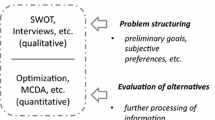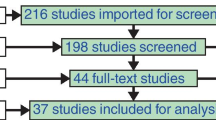Forest management is becoming a complex process that requires decision making involving economic, environmental and social criteria. This means that multiple criteria decision-making (MCDM) approaches need to be used in many forestry contexts. This chapter aims at assessing the efforts undertaken over the last 30 years towards formulating and solving forest management problems from an MCDM perspective. The goal of the chapter is not to compile an exhaustive list of MCDM applications in forestry but to detect the areas within forest management in which MCDM approaches have proven to be more productive or have significant future potential.
Access this chapter
Tax calculation will be finalised at checkout
Purchases are for personal use only
Preview
Unable to display preview. Download preview PDF.
Similar content being viewed by others
References
Bantayan, N. C., and Bishop, I. D., 1998, Linking objective and subjective modelling for landuse decision-making. Landscape and Urban Planning 43: 35-48.
Bell, D. E., 1977, A decision analysis of objectives for a forest pest problem, in: Conflicting Objectives in Decisions, D. D. Bell, R. L. Keeney, and H. E. Raiffa, ed., Wiley, New York, pp. 389-418.
Bertier, P., and Montgolfier, J., 1974, On multicriteria analysis: an application to a forest management problem. Metra 13: 33-45.
Bertomeu, M., and Romero, C., 2001, Managing forest biodiversity: a zero-one goal programming approach. Agricultural Systems 68: 197-213.
Bertomeu, M., and Romero, C., 2002, Forest management optimisation models and habitat diversity: a goal programming approach. Journal of the Operational Research Society 53: 1175-1184.
Bevers, M., and Hof, J., 1999, Spatially optimizing wildlife habitat edge effects in forest management linear and mixed-integer programs. Forest Science 45: 249-258.
Bojórquez-Tapia, L. A., De La Cueva, H., Díaz, S., Melgarejo, D., Alcantar, G., Solares, M. J., Grobet, G., and Cruz-Bello, G., 2004, Environmental conflicts and nature reserves: redesigning Sierra San Pedro Mártir National Park, Mexico. Biological Conservation 117: 111-126.
Bousson, E., 2001, Development of a multicriteria decision support system adapted to multiple-use forest management: application to forest management at the management unit level in Southern Belgium, in: Criteria and Indicators for Sustainable Forest Management at the Forest Management Unit Level, A. Franc, O. Laroussinie, and T. Karjalainen, eds., EFI Proceedings, Joensuu, Finland, pp. 151-164.
Buongiorno, J., Dahir, S., Chih Lu, H., and Ching-Rong, L., 1994, Tree size diversity and economic returns in uneven-aged forest stands. Forest Science 40: 83-103.
Buongiorno, J., Peyron, J. L., Houllier, F., and Bruciamacchie, M., 1995, Growth and management of mixed-species, uneven-aged forests in the French Jura: implications for economic returns and tree diversity. Forest Science 41: 397-429.
Carter, D. R., Vogiatzis, M., Moss, C. B., and Arvanitis, L. G., 1997, Ecosystem management or infeasible guidelines? Implications of adjacency constraints for wildlife habitat and timber production. Canadian Journal of Forest Research 27: 1302-1310.
Chang, S., and Buongiorno, J., 1981, A programming for multiple use forestry. Journal of Environmental Management 13: 45-58.
Charnes, A., and Cooper, W. W., 1961, Management Models and Industrial Applications of Linear Programming, John Wiley and Sons, New York.
Cohon, J. L., 1978, Multiobjective Programming and Planning, Academic Press, New York.
Diaz-Balteiro, L., and Romero, C., 1998, Modeling timber harvest scheduling problems with multiple criteria: an application in Spain. Forest Science 44: 47-57.
Diaz-Balteiro, L., and Romero, C., 2003, Forest management optimisation models when carbon captured is considered: a goal programming approach. Forest Ecology and Management 174: 447-457.
Diaz-Balteiro, L., and Romero, C., 2004, Sustainability of forest management plans: a discrete goal programming approach. Journal of Environmental Management 71: 351-359.
Diaz-Balteiro, L., and Romero, C., 2004, MCDM and forest management: a review. Working Paper, Technical University of Madrid.
Ducey, M. J., and Larson, B. C., 1999, A fuzzy set approach to the problem of sustainability. Forest Ecology and Management 115: 29-40.
Field, D. B., 1973, Goal programming for forest management. Forest Science 19: 125-135.
Field, R. C., Dress, P. E., and Fortson, J. C., 1980, Complementary linear and goal programming procedures for timber harvest scheduling. Forest Science 26: 121-133.
Forman, E. H., and Gass, S. I., 2001, The analytic hierarchy process-an exposition. Operations Research 49: 469-486.
Fraser, N. M., and Hauge, J. W., 1998, Multicriteria approval: application of approval voting concepts to MCDM problems. Journal of Multi-Criteria Decision Analysis 7: 263-272.
Hotvedt, J. E., 1983, Application of linear goal programming to forest harvest scheduling. Southern Journal Agricultural Economics 15: 103-108.
Hotvedt, J. E., Leuschner, W. A., and Buhyoff, G. J., 1982, A heuristic weight determination procedure for goal programs used for harvest scheduling models. Canadian Journal of Forest Research 12: 292-298.
Ignizio, J. P., 1976, Goal Programming and Extensions, Lexington Books, Lexington, MA.
Ignizio, J. P., and Romero, C., 2003, Goal programming, in: Encyclopedia of Information Systems, Vol. 2, H. Bidgoli, ed., Academic Press, San Diego, CA, pp. 489-500.
Kangas, J., Alho, J. M., Kolehmainen, O., and Mononen, A., 1998, Analyzing consistency of experts’ judgements-case of assessing forest biodiversity. Forest Science 44: 610-617.
Kangas, J., and Kangas, A., 2002, Multiple criteria decision support methods in forest management: an overview and comparative analyses, in: Multi-Objective Forest Planning, E. T. Pukkala, ed., Kluwer Academic Publishers, pp. 37-70.
Kangas, J., and Kangas, A., 2003, Multicriteria approval and Smaa-O in natural resources decision analysis with both ordinal and cardinal criteria. Journal of Multi-Criteria Decision Analysis 12: 3-15.
Kangas, J., and Kuusipalo, J., 1993, Integrating biodiversity into forest management planning and decision-making. Forest Ecology and Management 61: 1-15.
Kangas, J., and Pukkala, T., 1996, Operationalization of biodiversity as a decision objective in tactical forest planning. Canadian Journal of Forest Research 26: 103-111.
Kao, C., and Brodie, J. D., 1979, Goal programming for reconciling economic, even flow, and regulation objectives in forest harvest scheduling. Canadian Journal of Forest Research 9: 525-531.
Keeney, R. L., and Raiffa, H., 1976, Decision with Multiple Objectives: Preferences and Value Trade-Offs, John Wiley and Sons, New York.
Kuusipalo, J., and Kangas, J., 1994, Managing biodiversity in a forest environment. Conservation Biology 8: 450-460.
Laukkanen, S., Kangas, A., and Kangas, J., 2002, Applying voting theory in natural resource management: a case of multiple-criteria group decision support. Journal of Environmental Management 64: 127-137.
Laukkanen, S., Palander, T., and Kangas, J., 2004, Applying voting theory in participatory decision support for sustainable timber harvesting. Canadian Journal of Forest Research 34: 1511-1524.
Mendoza, G. A., and Prabhu, R., 2001, A fuzzy analytic hierarchy process for assessing biodiversity conservation, in: The Analytic Hierarchy Process in Natural Resource and Environmental Decision Making., D. L. Schmoldt, J. Kangas, G. A. Mendoza, and M. Pesonen, ed., Kluwer Academic Publishers, Dordrecht, pp. 219-233.
Mendoza, G. A., and Prabhu, R., 2000, Multiple criteria decision making approaches to assessing forest sustainability using criteria and indicators: a case study. Forest Ecology and Management 131: 107-126.
Mendoza, G. A., and Prabhu, R., 2003, Qualitative multi-criteria approaches to assessing indicators of sustainable forest resource management. Forest Ecology and Management 174: 329-343.
Mendoza, G. A., and Sprouse, W., 1989, Forest planning and decision making under fuzzy environments: an overview and illustration. Forest Science 35: 481-502.
Mendoza, G. A., Hartanto, H., Prabhu, R., and Villanueva, T., 2002, Multicriteria and critical threshold value analysis in assessing sustainable forestry: model development and application. Journal of Sustainable Forestry 15: 25-62.
Önal, H., 1997, Trade-off between structural diversity and economic objectives in forest management diversity. American Journal of Agricultural Economics 79: 1001-1012.
Önal, H., 1997, A computationally convenient diversity measure: theory and application. Environmental and Resource Economics 9: 409-427.
Phua, M., and Minowa, M., 2004, A GIS-based multi-criteria decision making approach to forest conservation planning at a landscape scale: a case study in the Kinabalu Area, Sabah, Malaysia. Landscape and Urban Planning, 71: 207-222.
Pukkala, T., and Kangas, J., 1993, A heuristic optimisation method for forest planning and decision-making. Scandinavian Journal of Forest Research 8: 560-570.
Pykalainen, J., Pukkala, T., and Kangas, J., 2001, Alternative priority models for forest planning on the landscape level involving multiple ownership. Forest Policy and Economics 2: 293-306.
Riitters, K., Brodie, J. D., and Kao, C., 1982, Volume versus value maximization illustrated for Douglas-fir with thinning. Journal of Forestry 80: 83-89, 107.
Romero, C., 2001, Extended lexicographic goal programming: a unifying approach. Omega. The International Journal of Management Science 29: 63-71.
Romero, C., 2004, A general structure of achievement function for a goal programming model. European Journal of Operational Research 153: 675-686.
Roy, B., 1968, Classement Et Choix En Presence De Points De Vue Multiples (La Methode ELECTRE). Revue Francaise d’Informatique et de Recherche Operationnelle 8: 57-75.
Roy, B., 1991, The outranking approach and the foundations of ELECTRE methods. Theory and Decision 31: 49-73.
Saaty, T. L., 1977, A scaling method for priorities in hierachical structures. Journal of Mathematical Psychology 15: 234-281.
Saaty, T. L., 1980, The Analytic Hierachy Process: Planning, Priority Setting, and Resource Allocation, McGraw-Hill, New York.
Schmoldt, D. L., and Peterson, D. L., 2000, Analytical group decision making in natural resources: methodology and application. Forest Science 46: 62-75.
Schmoldt, D. L., and Peterson, D. L., 2001, Efficient group decision making in workshop settings, in: The Analytic Hierarchy Process in Natural Resource and Environmental Decision Making, D. L. Schmoldt, J. Kangas, G. A. Mendoza, and M. Pesonen, ed., Kluwer Academic Publishers, Dordrecht, pp. 97-114.
Shields, D. J., Tolwinski, B., and Kent, B. M., 1999, Models for conflict resolution in ecosystem management. Socio-Economic Planning Sciences 33: 61-84.
Snyder, S., and Revelle, C., 1997, Multiobjective grid packing model: an application in forest management. Location Science 5: 165-180.
Steuer, R. E., 1989, Multiple Criteria Optimization: Theory, Computation and Application, John Wiley and Sons, New York.
Tarp, P., and Helles, F., 1995, Multi-criteria decision-making in forest management planning - an overview. Journal of Forest Economics 1: 273-306.
Tecle, A., Shrestha, B. P., and Duckstein, L., 1998, A multiobjective decision support system for multiresource forest management. Group Decision and Negotiation 7: 23-40.
USDA Forest Service, 1997, Spectrum Users Guide, Ecosystem Management Analysis Center, Fort Collins, CO.
Yu, P. L., 1973, A class of solutions for group decision problems. Management Science 19: 936-946.
Zeleny, M., 1974, A concept of compromise solutions and the method of the displaced ideal. Computers & Operations Research 1: 479-496.
Author information
Authors and Affiliations
Editor information
Editors and Affiliations
Rights and permissions
Copyright information
© 2007 Springer Science+Business Media, LLC
About this chapter
Cite this chapter
Diaz-Balteiro, L., Romero, C. (2007). Multiple Criteria Decision-Making in Forest Planning: Recent Results and Current Challenges. In: Weintraub, A., Romero, C., Bjørndal, T., Epstein, R., Miranda, J. (eds) Handbook Of Operations Research In Natural Resources. International Series In Operations Research amp; Mana, vol 99. Springer, Boston, MA. https://doi.org/10.1007/978-0-387-71815-6_25
Download citation
DOI: https://doi.org/10.1007/978-0-387-71815-6_25
Publisher Name: Springer, Boston, MA
Print ISBN: 978-0-387-71814-9
Online ISBN: 978-0-387-71815-6
eBook Packages: Earth and Environmental ScienceEarth and Environmental Science (R0)




